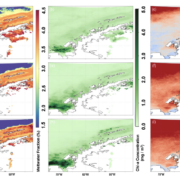New Paper: Influence of seasonally varying sea-ice concentration and subsurface ocean heat
Do you love 1-D ocean-sea ice models? Then check out the latest paper by Ben, Darren, Scott, Doug and Sharon. Kudos to the team!
For more, check out the abstract and citation below.
Processes driving changes in sea-ice seasonality and sea-ice thickness were explored for a ‘warm-shelf’ region along the West Antarctic Peninsula using vertically coupled sea-ice-ocean thermodynamic simulations, with and without assimilated satellite sea-ice observations and moored ocean temperature observations. Simulations with assimilated sea-ice observations permitted investigation of surface [thermodynamic and dynamic (e.g., wind-driven)] processes affecting sea-ice thickness and seasonality. Assimilation of quasi-weekly variability in the depth and temperature of the deep warm pycnocline permitted examination of subsurface processes affecting sea-ice. Simulations using assimilated sea-ice observations (and implied motion) always produced greater surface heat fluxes and overall thinner sea ice. Assimilating seasonal and quasi-weekly variability in the depth and temperature of the pycnocline modified the start of the sea-ice season by −23 to +1 d, and also modified the sea ice thickness/seasonality to be thinner/shorter or thicker/longer at sub-seasonal and seasonal timescales, highlighting a mechanism where a shoaling pycnocline enhanced upward deep-water heat fluxes as transient surface-induced turbulence had a greater effect on a reduced mixed layer volume. The observed interplay of surface, subsurface, and sea-ice modulation of ocean-atmosphere heat transfer underscores the importance of representing the interaction between sea-ice concentration and upper ocean variability in climate projections.
Saenz, B., McKee, D., Doney, S., Martinson, D., & Stammerjohn, S. (2023). Influence of seasonally varying sea-ice concentration and subsurface ocean heat on sea-ice thickness and sea-ice seasonality for a ‘warm-shelf’ region in Antarctica. Journal of Glaciology, 1-17. https://doi.org/10.1017/jog.2023.36





 2025
2025

 This site was developed with the support of the National Science Foundation under Grant No. OPP-2224611 and OPP-2026045. Any opinions, findings, and conclusions or recommendations expressed in this material are those of the authors and do not necessarily reflect the views of the National Science Foundation.
This site was developed with the support of the National Science Foundation under Grant No. OPP-2224611 and OPP-2026045. Any opinions, findings, and conclusions or recommendations expressed in this material are those of the authors and do not necessarily reflect the views of the National Science Foundation.
